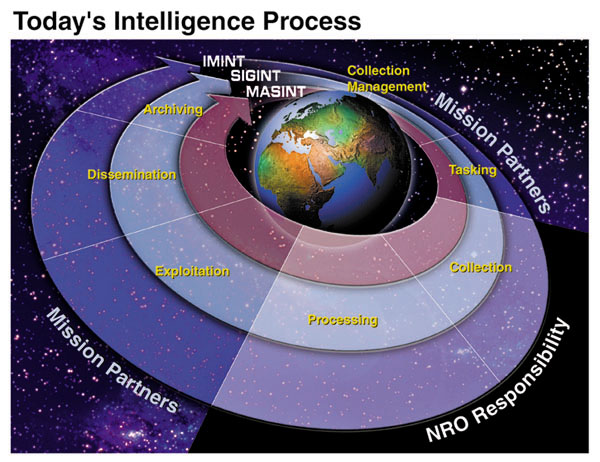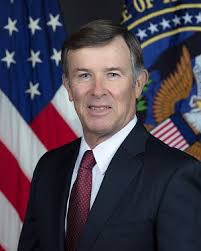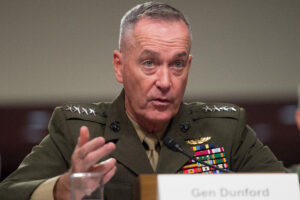
UPDATED: Adds Comment From Former NRO Director Marty Faga
WASHINGTON: If war in space erupts, the new US Space Command will have the power to order the National Reconnaissance Office (NRO) to take “defensive space operations” under a new joint concept of operations. The new chain of command represents a tectonic plate shift in US national security space, which has long been plagued by often testy relationships between the Intelligence Community and DoD.
“For the first time, there will be a unified structure that fully integrates Intelligence Community and Department of Defense space defense plans, authorities and capabilities to ensure seamless execution of space defense systems,” Acting Director of National Intelligence Joseph Maguire told the National Space Council today.
“Furthermore, should conflict extend to space, the NRO will take direction from the Commander of US Space Command and execute defensive space operations based on a jointly developed playbook and informed by a series of exercises and war games,” Maguire added.
Marty Faga, former NRO director, says the speed of attacks on satellites is a prime driver behind the need for this sort of policy change. “A big problem at least currently for all of our systems, military and IC, is that many forms of attack will come with no warning like cyber, jamming and laser. Moreover, kinetic ASAT attack in LEO takes 8 minutes from launch to strike. It will be quite a while before our ability to detect, track and respond will be that fast,” he says.
Maguire admitted that establishing coordination and cooperation between the NRO — which builds and operates US spy satellites — and US military space operations (even in wartime) has been an almost impossible task. As Breaking D readers know, for two years the former NRO Director, Betty Sapp, resisted efforts by the two top civilians in the Defense Department to create what in 2017 became the National Space Defense Center (NSDC) under Strategic Command. And NSDC’s power to integrate NRO and military space activities was limited.
Commanders in the field for decades have been clamoring (even as this is being written) for their own satellite systems that would be more responsive to their immediate tactical needs, rather than having to wait for the Intelligence Community to re-prioritize the NRO’s relatively few and usually exquisite satellites. The Army, in particular, has plans to develop its own remote sensing and other types of satellites in Low Earth Orbit (LEO).
But the Air Force, which controls about 90 percent of the DoD’s space budget, also has clashed with NRO over perceived priority needs. “This is a big deal,” one Air Force insider said, noting that currently NRO, the Air Force and NASA meet three times a year to “untie these knots.”

Joseph Maguire
“For years there have been debates about how NRO and military space organizations can be better integrated,” Maguire conceded. He explained that Space Policy Directive-4, issued in February, not only called for a new Space Force, but tasked the IC and DoD to develop an “enhanced mechanism” designed to “increase unity of effort and effectiveness” of space operations.
“Early in this task, we recognized that the proposed establishment of US Space Command provided us with the opportunity to finally determine the appropriate level of integrations between the Intelligence Community and DoD to ensure effective space operations,” he said.
“This has certainly been the direction the world has been heading for some time. I have always argued,” Faga says in his email, “that there can be circumstances where the Commander sees a risk and orders a defensive response. Meanwhile, the DNI might recognize that an intel satellite that may be destroyed in 10 minutes is about to do some collection so important that the risk to the satellite is worth it. I assume that the playbook will provide for this possibility, should it arise which is unlikely. I noted ADM Maguire’s emphasis on the joint nature of the NSDC as a DOD-IC activity. That’s like the NRO itself. So, it will be interesting to see what the space playbook turns out to be.”
The new organizational structure will maintain the NSDC at Strategic Command that was established in April 2017 to integrate NRO data into military space operations, but will expand its remit and deepen interagency ties.
Meanwhile, the NSDC will be shifted to US Space Command, once the command is formally stood up on Aug. 29 by Vice President Mike Pence, as announced today by Gen. Joseph Dunford, chairman of the Joint Chiefs of Staff. Dunford said that initially 87 units will be transferred to the new unified command under Gen. John Raymond. Raymond’s mission, he said, will focus on “missile warning, satellite operations, space control and space support.”
Dunford set this debate in motion almost four years ago, as our readers know, when he told the Senate Armed Service Committee in written questions during his nomination hearing that:
“While I believe that our military forces are generally most effective when they operate under a military chain of command, there are circumstances in which exceptions to this general rule are appropriate; authorities and agreements exist to facilitate the granting of such exceptions.” This marked the first time a senior official has discussed who might command whom in wartime. The question had been left unanswered until then because most experts expected war might be watched from space but would not extend to space.

Gen. Joseph Dunford
“After months of analysis and deliberation, the Intelligence Community and the Department of Defense have agreed to align US space command and the NRO into a new unified defense concept of operations at the National Space Defense Center,” Maguire said. “As part of US Space Command, the National Space Defense Center is a joint DoD-Intelligence Community organization and will become the center of gravity for defending our vital interest in space.”
Maguire said that the new concept of operations is only one of some 50 recommendations suggested by the SPD-4 joint IC and DoD working group to improve cooperation and US “space operations posture,” that involved some 14 different agencies. “The best of those recommendations are being concluded in a report that will be presented to the President, and which is in final coordination and review,” he noted.
Maguire said the changes were spurred by the increased threat to US and allied space systems by “as China and Russia develop and field destructive weapons.” These include Chinese ground-based anti-satellite (ASAT) missiles, as Russian efforts to develop the same that he alleged “likely will be operational in the next few years.” He also charged Russia with having “fielded a ground-based laser weapon which can blind or damage our space-based optical sensors.”
“The threat to the US and allied space systems continues to grow unabated,” he said.
Doug Loverro, former deputy assistant secretary of defense for space policy, said that the new organizational structure represents a major, and welcome, change, but cautioned that “the devil will be in the details.”
“Still, we’ve been on this path for the last five years, and it is the natural destination in contested space,” he said.
Colin contributed to this story.
From F-16s to NATO, Argentina’s moves tilt West, but ties to China to last
There are flashpoints to watch as Argentina navigates its future between the polar attractions of Washington and Beijing, including future defense deals and a deep space facility.


























